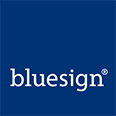- Clothes
- Bags
- Accessories
-
Inspiration
- Shoes

The BLUESIGN quality mark is used for both an end product or for the individual components that can lead to a product. In the case of clothing, an end product can therefore bear the BLUESIGN quality mark, but it is also possible to have a fabric manufacturer that is BLUESIGN certified.
The BLUESIGN label is active on a social and environmental level. The most important parts of the quality mark concern the economical and sustainable use of raw materials and ensure that no hazardous substances and chemicals are used.
A manufacturer that meets the BLUESIGN criteria is bluesign® APPROVED.
A product that bears the BLUESIGN quality mark is also referred to by BLUESIGN as a bluesign® PRODUCT. This certification is only given to brands that are fully committed to the BLUESIGN system. This means that at least 90% of their fabrics must be bluesign® APPROVED, and 30% of the accessories must be bluesign® APPROVED, for example the buttons, zippers and labels that are in the product. The goal is to have all components of the bluesign® APPROVED production of course.
Find out what's the story behind your clothing by understanding the certificates. Use the scores to discover at a glance what a certificate means in different sustainability areas.
Many clothes have seen more of the world than you.
In order to become the bluesign® APPROVED, a manufacturer must meet a number of criteria. In addition to the strict criteria, BLUESIGN also wants manufacturers to continue to improve and to produce in an increasingly environmentally friendly way. Some of their criteria are:
Score: 2/4 There are mainly rules for handling raw materials properly, avoiding hazardous substances, and creating as little waste as possible. There are no hard criteria that only sustainable materials can be used, and many of the criteria about sustainable use of energy and water are more what is recommended and where BLUESIGN still wants to see growth.

To become bluesign® APPROVED, the following fair trade criteria must be met:
The bluesign® SYSTEM PARTNERS (companies that have or are seeking to obtain the BLUESIGN seal of approval) are also encouraged to implement an even broader social system in their facility, for example through the Fair Wear Foundation or the SA8000. This is even mandatory for bluesign® SYSTEM PARTNERS where the criteria of BLUESIGN are violated during an inspection.
Score: 2/4 There is nothing in the criteria about a living wage or even a minimum wage. In addition, there is also nothing about a clean and healthy workplace or facilities such as toilets.

BLUESIGN does not have any animal welfare conditions for the production itself, but they do ask partners to consider animal welfare when purchasing their materials. They also recommend that you only purchase certified products.
Score: 1/4 Because it is mainly asked to include animal welfare in the decision for material choice, but no hard criterion is attached to it.
BLUESIGN conducts an assessment and prepares a summary. This includes the decision whether the company meets the bluesign CRITERIA. The report also includes recommendations on how the company can improve further. bluesign® SYSTEM PARTNERS are always encouraged to keep improving and also to take advantage of other certifications. The report is not publicly available.
Score: 3/4 A report is created and shared with the company along with recommendations for improvements.
BLUESIGN carries out its own inspections to see whether a company meets the BLUESIGN criteria. They visit the production location. BLUESIGN reserves the right to make an unannounced follow-up inspection, but they do not always do this. The inspection must take place every 3 years to maintain the certification.
Score: 2/4 The inspection is carried out by BLUESIGN and only once in the 3 years. There are not many unannounced inspections.
Together we can make a difference! Subscribe to the newsletter to stay up to date about fair and sustainable fashion. We plant a tree for every subscription! 🌳